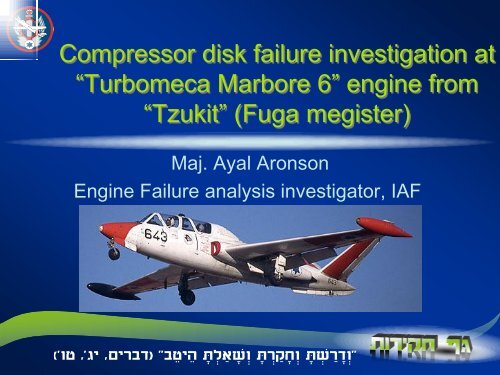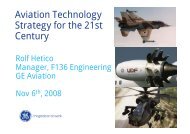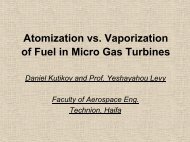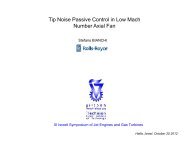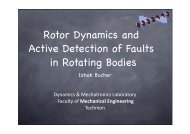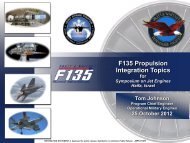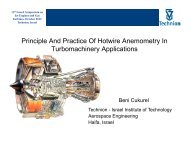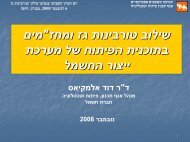Compressor failure in Marbore Engine
Compressor failure in Marbore Engine
Compressor failure in Marbore Engine
- No tags were found...
Create successful ePaper yourself
Turn your PDF publications into a flip-book with our unique Google optimized e-Paper software.
<strong>Compressor</strong> disk <strong>failure</strong> <strong>in</strong>vestigation at“Turbomeca <strong>Marbore</strong> 6” eng<strong>in</strong>e from“Tzukit” (Fuga megister)Maj. Ayal AronsonEng<strong>in</strong>e Failure analysis <strong>in</strong>vestigator, IAF
Failure analysis department• Our department is deal<strong>in</strong>g with:– All <strong>failure</strong> analysis <strong>in</strong>vestigations <strong>in</strong>volv<strong>in</strong>g flight safety.– All k<strong>in</strong>d of platforms, systems and materials.• The <strong>in</strong>vestigators are aeronautical, mechanical andmaterial eng<strong>in</strong>eers.• Each <strong>in</strong>vestigator specializes <strong>in</strong> different system(eng<strong>in</strong>es, lend<strong>in</strong>g gears, transmission gear, structureetc).• We are us<strong>in</strong>g advanced equipment:– Optical microscopy – magnificaion capabilities up to X180.– Scann<strong>in</strong>g Electron Microscope (SEM) – Field emission SEM(High resolution).• Eng<strong>in</strong>eer<strong>in</strong>g and lab support<strong>in</strong>g departments –metallurgy, analytical lab, measur<strong>in</strong>g lab, NDTcapabilities and more.2
The event details• While "tzukit" airplane (Fuga megister) was tra<strong>in</strong><strong>in</strong>g,an explosion was heard.• The explosion happened dur<strong>in</strong>g the runn<strong>in</strong>g fortakeoff.3
The event details• The airplane equipped with 2 “Turbomeca <strong>Marbore</strong> 6" jeteng<strong>in</strong>es.• Exam<strong>in</strong>ation of the airplane and the eng<strong>in</strong>e revealed that partsfrom the compressor broke the eng<strong>in</strong>e hous<strong>in</strong>g and some outerpanels were found over the runway.• The event has high potential for crash and <strong>in</strong> miracle f<strong>in</strong>ishedwithout <strong>in</strong>juries.4
5The eng<strong>in</strong>e that failed after his disassembly fromthe airplane
6Visual exam<strong>in</strong>ation - Parts break<strong>in</strong>g outfrom the eng<strong>in</strong>e’s hous<strong>in</strong>g
7The parts are from the compressor disk
The structure of the compressor• One centrifugal stage.• This stage is an assembly of sta<strong>in</strong>less steeldisk (the lead<strong>in</strong>g edge) and alum<strong>in</strong>um disk.9
The structure of the compressorThe sta<strong>in</strong>less steel diskSta<strong>in</strong>less steeldisk - thelead<strong>in</strong>g edgeAlum<strong>in</strong>um disk –the part thatfailed10The alum<strong>in</strong>um disk
The structure of the compressorThe tenon jo<strong>in</strong>ts atthe alum<strong>in</strong>um disk12
Compar<strong>in</strong>g between the disk that failed anda new oneThe undamagedsta<strong>in</strong>less steel disk2 ma<strong>in</strong> broken piecesfrom the alum<strong>in</strong>um disk13
15All the tenons <strong>in</strong> the disk that failed werebroken/sheared
Fractography• Exam<strong>in</strong>ation of both ma<strong>in</strong> fractures revealed “f<strong>in</strong>gernail“ areas conta<strong>in</strong><strong>in</strong>gbeachmarks that propagat<strong>in</strong>g from the tenon radius at the wall that carriesthe loads.“f<strong>in</strong>ger nail“ areasconta<strong>in</strong><strong>in</strong>g beachmarksthat propagat<strong>in</strong>g from thetenon radius.5mmX10mm16“f<strong>in</strong>ger nail“ areasconta<strong>in</strong><strong>in</strong>gbeachmarks thatpropagat<strong>in</strong>g fromthe tenon radius.10mmX20mm
All the tenons were found to be cracked atthe radius of the wall that carries the loadsThe fracture surfacethe radius of thewall that carriesthe loads17
Fractography• Microscopic exam<strong>in</strong>ation us<strong>in</strong>g SEM revealed fatiguestriations propagat<strong>in</strong>g from the tenon radius.fatigue StriationsX250018
Fractography– Corrosion dimples cover<strong>in</strong>g the side walls of the tenons.– Corrosion cover<strong>in</strong>g the fracture surface, Close to the orig<strong>in</strong>s.19
NDT by fluid penetration method.• 15 alum<strong>in</strong>um disks were exam<strong>in</strong>ed by fluid penetrationmethod (level 4).• Few disks were found with <strong>in</strong>dication of cracks at the tenon’sradius.• Most of the disks with <strong>in</strong>dications of corrosion pits.20
Metallurgical cross sections• “Wedge” open<strong>in</strong>g shape of the crack.• Transgranular comb<strong>in</strong>ed with <strong>in</strong>tergranular propagation.• Corrosion f<strong>in</strong>d<strong>in</strong>gs at the orig<strong>in</strong>s and around them.C-CD-D21
Summary and conclusions• The eng<strong>in</strong>e failed due cracks that <strong>in</strong>itiated and propagated <strong>in</strong> thealum<strong>in</strong>um disk of the compressor stage.• The cracks <strong>in</strong>itiated and propagated <strong>in</strong> a corrosion fatigue mechanism.– Accord<strong>in</strong>g to the literature – corrosion fatigue occurs when comb<strong>in</strong><strong>in</strong>gcorrod<strong>in</strong>g environment and cycl<strong>in</strong>g load<strong>in</strong>g.– The corrosion fatigue mechanism characterized by:• “Wedge” open<strong>in</strong>g shape of the crack.• Transgranular propagation that can be comb<strong>in</strong>ed with <strong>in</strong>tergranular propagation.• Corrosion f<strong>in</strong>d<strong>in</strong>gs at the orig<strong>in</strong>s and around them.• The <strong>in</strong>itiation occurred at the radius of the tenon, at the side that carriesthe loads.• The anomalies that were found <strong>in</strong> the measurements of the radiuses andthe corrosion pits that were found at the side walls of the tenons causedstress consecration and accelerated the <strong>in</strong>itiation of the <strong>failure</strong>.23
Summary and conclusions• The reason that this cracks were not found until now is because thema<strong>in</strong>tenance policy for NDT enabled choos<strong>in</strong>g between <strong>in</strong>spection underlow magnification or fluid penetration (Zyglo) method.• From the other disks that were found with cracks, it can be concluded thatanother severe event was prevented due to this <strong>in</strong>vestigation.• From the amount of corrosion pits and the difficulty to see the coat<strong>in</strong>g itcan be concluded that the protective coat<strong>in</strong>g was damaged and was notaffective.• The probability of FOD (Foreign Object Damage) as a cause of the <strong>failure</strong>was ruled out.– There were no signs for FOD over the sta<strong>in</strong>less steel disk– Other disks were found cracked (with smaller cracks).24
Recommendations• Recommendations for overhaulma<strong>in</strong>tenance of the disks:– Def<strong>in</strong>e the ma<strong>in</strong>tenance policy for NDT onlywith fluid penetration method.– Renewal of the protective coat<strong>in</strong>g.– Measur<strong>in</strong>g all the disks for anomalies <strong>in</strong> theradiuses of the tenons.– Exam<strong>in</strong>ation of all the disks for stronglycorroded disks25


